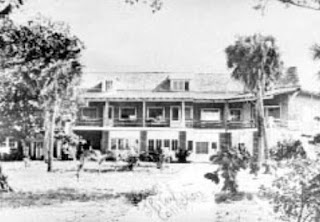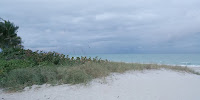 |
| First car in Miami belonged to C.H. Billings, 1899 a Locomobile Florida State Archives, Florida Memory |
By Jane Feehan
First, the national backdrop.
According to History.com, 30 American manufacturers produced 2,500 motorized vehicles by 1899. More than 480 companies entered the production fray a decade later. Henry Ford, though not the first car maker, produced the cheapest one, his Model T selling for $285 in October 1908 (preceded by his Model N for $500**).
Cars were referred to as “horseless carriages” in the 1890s. By 1900, the word “automobile” entered our lexicon. Automobile enthusiasts had already formed clubs and held races during the late 1800s and first decade of the 20th century.
Determining who owned the first automobile in Dade, Broward or
Palm Beach counties is problematic. Owning first and registering first don’t
match up and some records went missing. Some owned vehicles before registration was required. A registration ordinance, proposed in Miami in 1904
and passed in January 1905, details many of the same obligations as the requirements
codified by the state of Florida in 1905.
The umbrella requirement was that every auto had to be
registered with the Florida Secretary of State (the overseeing entity transferred
to the State Comptroller office in years following).
Some provisions will evoke a chuckle:
The vehicle registration number had to be displayed on a
tag “in Arabic numerals of at least 3 inches by 2 inches.”
Every vehicle operating on the road must have a bell,
horn or whistle and two lamps.
Motorists must signal when approaching horses or other
draft animals and must stop immediately if signaled to do so by one driving or
riding these animals.
Vehicles must abide by a reasonable speed and/or the state
determined speed limit.
Boards of county commissioners are empowered to set times
for speed tests or races on public roadways.
No vehicle can cross a street or turn a corner at more than 5 miles per hour (Miami ordinance).
Vehicle operators must be 16 years old (Miami
ordinance).
The first registration records were handwritten.
 |
| Florida Memory/Discover/historical records: https://www.floridamemory.com/items/show/346940 |
So, who owned the first motorized vehicle in Miami? News accounts indicate it was Mr. C.H. Billings, a construction "engineer," in 1899. He drove a steam-powered “locomobile (at top of this post)."The Miami Evening Record in 1904 described it as "fast" -- relevant to walking no doubt.
 |
| 1906 Model E Glide - Author unknown (Not Bryan's car) Cycle and Automobile Trade Journal Oct.1, 1905 |
The first car registered with the state (and probably first owned) of Broward County belonged to Fort Lauderdale pioneer
Reed A. Bryan in 1906. He drove a Glide (produced 1902-1925), a four-cylinder, 45-horsepower automobile.
It was later given to the city’s fire department for their use. There were far
fewer cars in Broward County; paved roads were rare. Only two were available in Fort Lauderdale: Brickell
and Andrews avenues. Both offered only single lanes.
George W. Potter, surveyor and illustrator from Boynton Beach in Palm Beach County beat Henry M. Flagler
to the state registration records. Potter registered his 4-horsepower Waltham Orient
Buckboard in November 1905. Flagler followed
the next month with registration of his open-air, quiet, steam-powered touring car
manufactured by White Motor Company.
An automobile section appeared in the Miami Herald in 1912 with “items of interest to automobilists everywhere.” After all, “the
greatest future lies ahead in the auto industry.” Prescient, indeed.
** See Ford Company history at:
__________
Sources:
https://www.boyntonhistory.org
Broward Legacy – Hughes, Kenneth Survey of old cars.
Vol. 21, No. 3-4, 1998 https://journals.flvc.org/browardlegacy/issue/view/3742
Miami Evening Record, Jan. 22, 1904
Miami News, Oct. 26, 1904
Miami Herald, Oct. 4, 1911
South Florida Sun-Sentinel, March 31, 2015

















